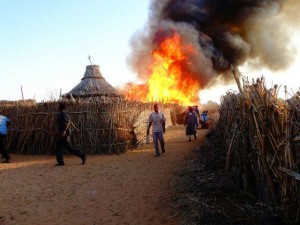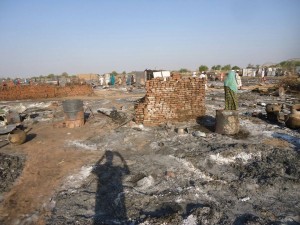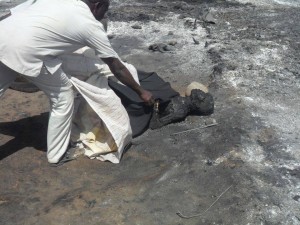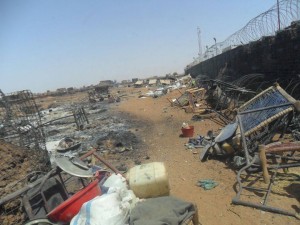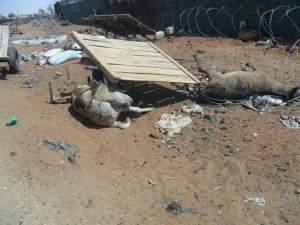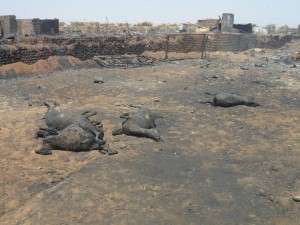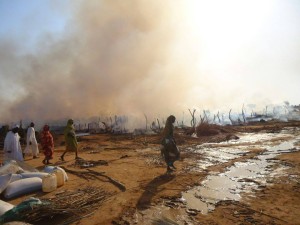The Human Rights Watch report on the mass rapes at Tabit: What it says about UNAMID
Eric Reeves | 12 February 2015 | http://wp.me/p45rOG-1B9
The shockingly revealing and detailed report issued yesterday by Human Rights Watch (HRW) on the mass rapes at Tabit, North Darfur, tells us not only about the excruciating suffering, humiliation, and continuing danger to the more than 200 women and girls who were raped (notably, the population of this town of some 7,000 is predominantly from the Fur African tribal group). We learn a great deal about the degree of accompanying violence, the savage beatings of men and boys, and the suffocating intimidation that followed the events of October 30 – November 1, 2014. We learn that the commander of the Sudan Armed Forces (SAF) garrison based near Tabit came to realize what he had let loose, and attempted to mollify the civilian population. But as Human Rights Watch stresses, SAF officers ordered their men to commit war crimes, which is what these sexual assaults amount to; indeed, Human Rights Watch makes clear that the threshold for crimes against humanity may well have been reached (page 2). Civilians in Tabit today describe their existence as “living in an open prison.” (The full HRW report—”Mass Rape in Darfur: Sudanese Army Attacks Against Civilians in Tabit”—may be accessed at | http://www.hrw.org/news/2015/02/11/sudan-mass-rape-army-darfur.)
To all this Khartoum’s response remains the same: a total denial of all that Human Rights Watch reports on the basis of extensive interviews with victims and eyewitnesses. The SAF has been particularly adamant in denying that its forces at Tabit committed any crimes. Foreign Minister Ali Karti, recently invited to Washington, DC to attend the National Prayer Breakfast has previously been the most outspoken official in denying the realities of Tabit, and it is highly unlikely that he will back off this denial. Khartoum appointed a “special investigator” who dutifully went to Tabit, found “no evidence” of rapes, and as far as the regime was concerned that ended the matter, especially since a publicly issued report by the UN/African Union “hybrid” Mission in Darfur (UNAMID) declared baldly that:
None of those interviewed confirmed that any incident of rape took place in Tabit on the day of that media report [by Radio Dabanga, 2 November 2014]. The team neither found any evidence nor received any information regarding the media allegations during the period in question. (UNAMID press release [el-Fasher], 10 November 2014)
But in an internal UNAMID document prepared at the same time and leaked to me soon afterward, we catch a clear view of the disingenuousness and mendacity that have long characterized UNAMID’s reporting (see http://wp.me/s45rOG-5903). Agence France-Presse had reported on the leaked document briefly on 12 November 2014—two days after the official, and very brief, press release declared simply that UNAMID found “no evidence” of rapes at Tabit:
The report by the joint UN-AU mission in Darfur suggests that a visit by a team of monitors to the village of Tabit was carefully prepared by the Sudanese military to prevent witnesses from coming forward. During the team visit, there was a heavy presence of Sudanese soldiers who followed the monitors and recorded interviews with the villagers, according to the UN-African Union Mission in Darfur (UNAMID) report obtained by AFP.
“The behavior and responses of interviewees indicated an environment of fear and intimidation,” said the report on the Sunday visit. “Some of the sub-teams had to ask the military personnel to stop following them and also asked them to allow the conduction of interviews in some privacy,” it added. The report quoted a villager in Tabit who said the soldiers had told the community “not to provide information to UNAMID” and that “reportedly a committee was formed to interact” with the fact-finding mission. (AFP, 12 November 2014 | http://news.yahoo.com/sudan-military-sought-intimidate-during-mass-rape-probe-200354793.html)
The intimidation of Tabit’s residents—including threats of murder should anyone speak about what actually happened—are detailed in the HRW report of yesterday, the product of three months of investigation and more than 100 interviews, including with actual victims of the sexual assaults (see pages 29 – 35). The report is supplemented by the findings of three Sudanese national groups working independently of the regime. Among those interviewed were two soldiers of the SAF present in Tabit at the time (and who subsequently deserted):
Two government soldiers who participated in the attacks told Human Rights Watch that they were directly given orders from superior officers to “rape women,” because the women were rebel supporters; three government soldiers said they witnessed other soldiers raping women.” SAF troops reportedly entered the village in search of a missing soldier whom they believed was abducted and conducted house-to-house searches during three days of operations.
Neither UNAMID nor the UN has acknowledged the existence of the internal UNAMID document except implicitly by calling for further investigation of Tabit. Since Russia is determined to block the authorization of any new investigation at the Security Council—as is well known to the UN Secretariat—it is the height of hypocrisy for Ban Ki-moon’s spokesman, Stephane Dujarric, to tell reporters yesterday (11 February 2015) “that while he welcomed the Human Rights Watch report, the United Nations’ own methodology required access on the ground. ‘For us, safe, unhindered access to the town is critical,’ he said.”
“The United Nations’ own methodology”? This is grotesque and finally insidious self-celebration of the UN’s dismal record of human rights investigating. Indeed, Dujarric’s comment is nothing more than a way to dismiss the HRW report as perhaps useful but not up to required UN standards, standards that require a presence that clearly will not be allowed. The full implications of the 48-page HRW report are thus rendered provisional, even as we know that there will be no UN action or meaningful demands for further investigation. On the other hand, anyone who knows the extraordinarily high standards that guide all HRW reports, the exceedingly demanding requirements for corroboration, and the assiduous research by chief investigator Jonathan Loeb, will know that the UN could not possibly produce a report as revealing as the one being dismissed for lack of an impossible direct access to Tabit.
When it comes to Darfur, the UN has proved endlessly resourceful in denying or obfuscating the truth about what people are suffering, just how massive the destruction is, and the accelerating nature of violence, especially in North Darfur (where Tabit is). Comments on the performance, adequacy of equipment, the degree of competency of various personnel, and even UNAMID deployment out of Darfur are rarely offered. For example, my inquiry a month ago of Tony Banbury, the official in charge of the UN response to Ebola in western Africa, was very specific and required only a yes or no answer:
Could you confirm/disconfirm what has been reported from New York, viz. that more than four hundred 4×4 vehicles have been redeployed from Darfur to West Africa in response to the Ebola crisis?
I received no answer, as has been true on the occasion of many inquiries, despite a publication record that indicates my status, in one capacity, is that of a journalist. If true, however, such redeployment would mark a very significant reduction in mobility for UNAMID, which has already been drawn down by 6,000 personnel since 2012. The man responsible for this draw-down, based on what he claimed were improving security conditions in Darfur, is Hervé Ladsous the French head of the UN Department of Peacekeeping Operations (UN DPKO).
I received on 11 February 2015 a plea from a young man in the Darfuri diaspora: he had just seen photographs of what had been the IDP camp where his family lived, but their fates are now unknown. The photographs this young man sent to me were taken in the immediate aftermath of the event (several weeks ago) he could describe only briefly what he had heard from those on the ground: “Janjaweed came to their [my family’s] IDP camp and start killing people and looting their life stocks in front of UNAMID eyes; when civilians came went to UNAMID seeking refuge they turned them away…”
I believe it is unwise to identify the camp with any particularity, especially since it shares an increasingly common fate, one that is all too revealing of what UNAMID has become.
In fact, UN DPKO is now attempting to walk quietly away from UNAMID, washing its hands of the whole mission and its massive failure. Privately, senior UN DPKO officials—including Ladsous—admit that UNAMID is a failed mission, but they blame this failure on the “hybrid” nature of the peacekeeping force. And indeed the very notion of a “hybrid” force—first mooted in fall 2006 after Khartoum rejected the terms of a UN Security Council resolution mandating a true UN peacekeeping mission—was always disastrous. It was the result of political cowardice on the part of the UN, including UN DPKO. When pressed about ways of improving the ability of the mission to protect civilians, such as the women and girls who were raped at Tabit and then abandoned by UNAMID investigators, these senior DPKO officials make clear there are no plans of this sort—that they are, in effect, prepared to see the mission die of neglect, mismanagement, lack of resources, and inadequate insulation of UNAMID from the hostility of the Khartoum regime, which over the years has taken many forms.
But such a consequential decision of abandonment should be conveyed publicly, not privately to a few individuals. Millions of lives are in the balance, and the savagery of the attack on Tabit makes clear that UNAMID needs to be overhauled, supplemented, and given decisive UN support for its civilian protection mandate. The Status of Forces Agreement (negotiated with Khartoum in February 2008)—granting UNAMID the right to travel throughout Darfur without restriction—should be vigorously insisted upon. As it is, UNAMID is frequently denied access to the sites of atrocity crimes, including Tabit. The meek acceptance of these denials by UNAMID is longstanding. The terrible Tabarat massacre in Darfur, in which more than fifty African men and boys were killed by gunshots from point-blank range by militia forces in September 2010, is a ghastly exemplar of UNAMID’s failure to respond to or even investigate the most urgent reports in real time (see http://wp.me/p45rOG-Gi). More than four years later there is still no UNAMID report on Tabarat (very close to the UNAMID base at Tawilla); we depend on a dispatch from the time by an investigative reporter with Reuters (Appendix One below).
It was to this attack on an IDP camp that UNAMID was completely unresponsive and refused to help survivors. This woman (I believe it is a woman) was burned to death.
HRW’s commentary on the future of UNAMID is in many ways congruent with my own:
The UN and the AU have been reviewing and downsizing UNAMID. Officials have indicated that this process has been driven by several factors including Sudan’s hostility to the mission, the mission’s high cost, and its longstanding ineffectiveness with respect to its core mandate, and the perception that the conflict in Darfur is subsiding and no longer requires a robust peacekeeping force. The withdrawal of peacekeepers could undermine what little protection the mission has afforded the people of Darfur. (page 17; emphasis added)
The UN and AU (African Union) are currently reviewing UNAMID. The evaluation should focus on how to urgently improve and bolster the ability of UNAMID to protect people from the kinds of horrific abuses that occurred in Tabit, and effectively investigate human rights abuses without endangering victims and witnesses. (page 37; emphasis added)
Violence and human destruction are accelerating throughout Darfur, if most notably in North Darfur. Khartoum’s Rapid Response Forces (RSF) are proving to be better armed and more cohesive than the Janjaweed of old; and they work with the open support of the regime. If UNAMID continues to wither, if its failure deepens, if its ability to protect civilians and humanitarians continues to deteriorate rapidly, then the international humanitarian presence is likely to be a major casualty in the near future—long a primary goal of the regime. The exit of these relief organizations will precipitate an extremely rapid decline in access to food, clean water, and primary medical care. And without international eyes on the ground, there will be no witnesses that Khartoum might fear. In this vein, Khartoum has done its best to block Radio Dabanga, which broadcasts from The Netherlands and is available on-line (in Arabic and English) at www.radiodabanga.org (see my recent assessment of Radio Dabanga | http://wp.me/p45rOG-1B4). It is the most popular radio broadcast in Sudan, and it is only a matter of time before Darfuris themselves are denied access by technological means to what is listened to every day, in every village and camp.
This kind of comprehensive destruction marked the early days of the Darfur genocide and is again becoming the hallmark of the Rapid Support Forces—the “new Janjaweed”
And if the UN as represented by Mr. Dujarric is any indication, we may be sure that these reports—highly detailed, drawn from an extraordinarily wide range of sources on the ground in Darfur, and impressive in their continually growing professionalism—will be dismissed as “methodologically deficient” by UN standards. No matter that UN standards ensure that nothing is investigated, or that the UN provides no assistance in expanding investigatory abilities and access for UNAMID.
Of course understanding more fully what is occurring in Darfur, and a broader public awareness of how badly UNAMID is performing, are not in the interest of Hervé Ladsous and his Department of Peacekeeping Operations. They wish not to bolster this failing but still very expensive Mission; rather they would prefer that it to die a slow, withering, disgraceful death. Thus on 27 March 27 2012, Voice of America reported on Ladsous’ views of diminishing peacekeeping needs in Darfur:
UN peacekeeping chief Hervé Ladsous noted a marked decrease in the organized violence that raged in Darfur. (emphasis added)
He was echoed shortly thereafter by UNAMID spokesman Christopher Cycmanick:
In an interview with Radio Dabanga (May 20, 2012), the spokesman for the UN/African Union Mission in Darfur (UNAMID), Christopher Cycmanick, “described the security situation in Darfur as ‘relatively calm.'” (emphasis added)
These were preposterous and utterly expedient assessments at the time, and have been fully disgraced by the continuing acceleration of violence and insecurity. But only because Ladsous felt so comfortable dismissing the reports from Radio Dabanga, and those coming to me and others confidentially from the ground at the time, was he able to make this obscene claim. A brief compendium of the many hundreds of reports of violence—violence that was conspicuous at the time Ladsous spoke, and accelerated rapidly throughout 2012—may be found in Appendix Two.
But it was on the basis of Ladsous’ assessment that 6,000 UNAMID personnel were withdrawn quietly from the Mission. And we may be sure that there will be no serious commitment to re-authorize a robust, unfettered UNAMID when its current Security Council authorization expires (June 2015). Indeed, even the current weak and demoralized force is likely to face a Russian veto in the vote on re-authorization. Notably, Russia continues to side with Khartoum on the events at Tabit: there were no rapes and there is no need for further investigation, Russia insists—and has made good on this by threatening to block any Security Council action authorizing such an investigation. Given President Vladimir Putin’s current desire to thwart any initiative, on any issue, coming from the U.S. or the Europeans, the odds are distinctly against re-authorization. And if re-authorization occurs, we may be all too sure that Khartoum will insist that the mission be yet smaller, weaker, with a less robust civilian protection mandate, and a re-negotiated Status of Forces Agreement, one that would formally allow Khartoum to deny access to the Mission, which of course it does now constantly in violation of the SOFA negotiated in February 2008.
The abandonment of Darfur has been occurring steadily over a number of years. Outrageous claims about levels of violence made by the various heads of UNAMID and UN DPKO are only one part, but an important part, of this abandonment. But this process is now culminating. And rather than serve as a warning to Khartoum, the Human Rights Watch report all too likely gives us a searing glimpse of the near future as well as the recent past.
More images from the destroyed IDP camp noted above; it is to this that the international community has become indifferent, supported in this indifference by the mendacity and duplicity of the UN Department of Peacekeeping Operations and its chief, Hervé Ladsous.
***********************************************************************
APPENDIX ONE:
Exclusive: Darfur attack survivors tell of brutal killings
Opheera McDoom (KHARTOUM | Fri September 17, 2010)
(Reuters) – Darfuri men were shot dead at point blank range during a surprise Arab militia raid on a busy market this month in which at least 39 people were killed and almost 50 injured, eyewitnesses said on Friday. The attack on civilians was reminiscent of the early years of the counter-insurgency operation in Sudan’s west, which took up arms against the government in 2003, complaining that the region had been neglected by Khartoum The International Criminal Court in The Hague has since issued an arrest warrant for Sudanese President Omar Hassan al-Bashir for genocide and war crimes in Darfur, charges he denies.
Details of the September 2 attack on the market in the village of Tabarat have not previously come to light. The government prevented peacekeepers from visiting the site until days later. But five survivors of the attack told Reuters that heavily armed Arab militia had targeted male victims and shot many at point blank range.
One diplomat said the militia were likely from among those armed and mobilized by the government to quell the rebels. Those militia, known as Janjaweed, were responsible for mass rape, murder and looting. Many of the tribal militia still support the government but Khartoum has lost control over some.
In Tabarat, men were rounded up by militia wearing military uniforms who rode into the market on horses and camels pretending to be buying goods before spraying the shops with gunfire. Then vehicles mounted with machine guns and carrying militia fighters appeared and rounded up some of the men, survivors said.
“They laid them down and they came up close and shot them in their heads,” Abakr Abdelkarim, 45, told Reuters by telephone from the town of Tawilla, where many of the victims had sought refuge and medical help. “(Those killed) were all men and one woman — some men were tied with rope behind the cars and dragged until they died.”
RUN FOR HIS LIFE
Adam Saleh said he had run for his life and hidden in nearby fields to watch from afar. “They were targeting men — all of them were shot in the head and chest, only those who were running away got shot in their legs and arms.” Nour Abdallah, 45, said the attackers let most of the women run away. She could not escape and so lay face down in the dirt. “They told me not to lift my head up or I would be shot too.”
Saleh and others said after the attack they had gone to the joint U.N.-African Union (UNAMID) peacekeeping base in Tawilla to ask peacekeepers to come to Tabarat but they had refused.
“They also refused to come and help us recover the bodies,” Saleh added.
UNAMID has said both rebels and the government prevented it getting access to the area. A UNAMID spokesman said he could not comment on the witness reports but an internal document seen by Reuters showed UNAMID had received similar witness reports of men being executed. The only aid agency working in Tawilla, Medecins Sans Frontières said it could confirm 39 people died and it had treated 46 injured, many with “serious gunshot wounds.” “We saw only men,” said MSF head of mission Alessandro Tuzza. He said he could not comment on how the victims were shot but that MSF was still negotiating with the government to get access to the area in North Darfur province.
The witnesses said they had buried 41 bodies in common graves but more were still in the bushes around the market. Sudan’s army denied involvement in the attack and said the local government was investigating. “The North Darfur government have formed a security committee to investigate this.” Presidential adviser Ghazi Salaheddin visited the area on Friday on a fact-finding mission.
Kidnapping and violent banditry have become frequent in Darfur where years of impunity and the ready availability of arms have fueled a breakdown in law and order, with foreign workers targeted for abductions even in the main towns.
Bashir expelled 13 of the largest aid agencies working in Darfur after the ICC arrest warrant last year and many gaps in the humanitarian operation have yet to be filled.
“We are begging the international aid agencies to come and give us food, water. We have women and children here sitting in the sun for days with no shelter. We have nothing,” said Abdelkarim.
APPENDIX TWO:
The fourteen analyses that are linked here all focus on violence and insecurity in Darfur; they are lengthy (typically 7,000 – 12,000 words) and contain confidential reports the UN did not have access to and a great deal of information reported only by Radio Dabanga, which has been consistently dismissed out of hand by nearly all UN and UNAMID officials. The African Union Peace and Security Council has also been deeply irresponsible in refusing to accept authoritative accounts of what is occurring in Darfur. Defensive of UNAMID, even in the face of its ghastly failure, officials of the African Union have been shameless in their lies. Former UNAMID head Ibrahim Gambari declared on retiring from his post in September 2012: “I am gratified to note that barely 31 months on, all the set goals and objectives have largely been met.” The African Union Peace and Security Council subsequently referred to UNAMID as “exemplary” for new peacekeeping missions in Africa.
The analyses span the entire year 2012; equivalent analyses for 2013 and 2014 are available at www.sudanreeves.org. The first three analyses are year-end summary assessments of insecurity and violence for all of 2012. The statement by UN head of peacekeeping Hervé Ladsous in March 2012, declaring that improved security permitted the large draw-down of UNAMID personnel (which has occurred) was—as is made all too fully clear here—despicably dishonest:
Human Security in Darfur, Year’s End 2012: North Darfur | 17 January 2013 | http://sudanreeves.org/2013/01/17/3736/
Human Security in Darfur, Year’s End 2012: South Darfur |11 January 2013 | http://sudanreeves.org/2013/01/11/human-security-in-darfur-years-end-2012-south-darfur/
Human Security in Darfur, Year’s End 2012: West Darfur | 27 December 2012 | http://sudanreeves.org/2012/12/27/human-security-in-darfur-years-end-2012-west-darfur/
Growing Violence in Darfur Deserves Honest Reporting, Not More Flatulent UN Nonsense | 1 December 2012 | http://sudanreeves.org/2012/12/01/growing-violence-in-darfur-deserves-honest-reporting-not-more-flatulent-un-nonsense/
Violence in Hashaba, North Darfur: A brutal portent, another UN disgrace | 30 October 2012 | http://sudanreeves.org/2012/10/30/violence-in-hashaba-north-darfur-a-brutal-portent-another-un-disgrace/
The Avalanche of Violence Continues to Accelerate in Darfur | 12 October 2012 | http://sudanreeves.org/2012/08/13/3376/
Darfur: UN Failure and Mendacity Culminate in an Avalanche of Violence” | 12 August 2012 | http://sudanreeves.org/2012/08/13/3376/
Darfur Update: “All the News that’s Fit to Ignore” | 15 June 2012 http://sudanreeves.org/2012/06/15/darfur-update-all-the-news-thats-fit-to-ignore/
Darfur in the Still Deepening Shadow of Lies | May 25, 2012 http://sudanreeves.org/2012/05/25/darfur-in-the-still-deepening-shadow-of-lies/
Former Members of the UN Panel of Experts for Darfur Offer a Damning Alternative to the “Official” Report | 17 April 2012 | http://sudanreeves.org/2012/04/17/former-members-of-the-un-panel-of-experts-for-darfur-offer-a-damning-alternative-to-the-official-report/
The Seen and the Unseen in Darfur: Recent reporting on violence, insecurity, and resettlement | 2 March 2012 | http://sudanreeves.org/2012/03/02/the-seen-and-the-unseen-in-darfur-recent-reporting-on-violence-insecurity-and-resettlement/
RAPE AS A CONTINUING WEAPON OF WAR IN DARFUR: Reports, bibliography of studies, a compendium of incidents | 4 March 2012 | http://sudanreeves.org/2012/03/04/rape-as-a-continuing-weapon-of-war-in-darfur-reports-bibliography-of-studies-a-compendium-of-incidents/
“‘They Bombed Everything that Moved’: Aerial military attacks on civilians and humanitarians in Sudan, 1999 – 2012” | (Extensive update to original text of monograph, 12 January 2012 | www.sudanbombing.org) http://sudanreeves.org/2012/01/13/they-bombed-everything-that-moved-aerial-military-attacks-on-civilians-and-humanitarians-in-sudan-1999-2012-january-12-2012
Second update | 5 June 2012 | http://sudanreeves.org/2012/06/13/they-bombed-everything-that-moved-june-5-2012-update/
